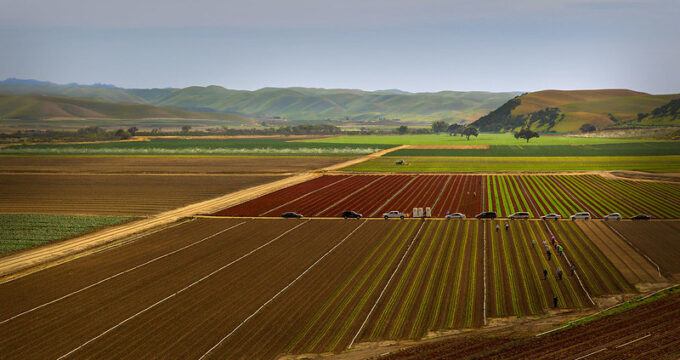Animal-Free Agriculture Is Key to Restoring Biodiversity
Animal-Free Agriculture Is Key to Restoring Biodiversity CounterPunch


Nature’s Complex Web: The Importance of Veganic Farming for Sustainable Development

Photograph Source: Malcolm Carlaw – CC BY 2.0
Introduction
Nature is complex. Her underground web is as intricate as her above-ground diversity. Below our feet, bacteria, microorganisms, mycorrhizae, and roots of perennial plants work symbiotically, absorbing and moving nutrients to wherever the need arises. Science has defined ecosystems and family groups, constantly updating our knowledge bank based on the most recent discoveries.
However, this is the human interpretation of the natural world, but the way other animal species interpret it is likely different. While all species tend to follow the rhythms of nature, there is one that seems to go against her: Homo sapiens.
The Impact of Unsustainable Exploitation
Our unsustainable exploitation of nature’s resources to meet our own needs is destroying the ecosystem. The global food system, for instance, is the leading cause of biodiversity loss. According to a 2021 report, “Food System Impacts on Biodiversity Loss,” biodiversity loss will continue to accelerate unless we change the way we produce food.
The need to produce more food at lower costs has led to increased usage of fertilizers, pesticides, energy, land, and water in agriculture. This has not only contributed to biodiversity loss but also made the global food system a leading cause of climate change.
The Urgent Need for Alternatives
There is a growing and urgent need to explore alternatives to these destructive agricultural practices. Veganic farming offers a way forward toward repairing the damage done to the ecosystem. It seeks to cultivate food for humans in a way that benefits all floral and faunal biodiversity.
Veganic farming involves the growing, gardening, cultivation, and production of food and fiber crops with minimal exploitation of animal and plant species. It does not use any animal products or byproducts, adhering to the main philosophy of cultivating for the benefit of all beings.
The Dark Side of Industrial Agriculture
Industrial-scale agriculture has had devastating consequences for the environment and human health. The use of pesticides, such as Monsanto’s Roundup containing glyphosate, has been linked to adverse health impacts and classified as a probable human carcinogen. Monoculture and the use of toxic manures have also led to soil degradation and negative environmental implications.
While organic agriculture initially offered hope, it has been undermined by large-scale agricultural corporations and for-profit organic standard certifiers. Non-organic manures containing genetically modified and antibiotic residues have been allowed over time, compromising the integrity of organic farming.
The Promise of Veganic Farming
Veganic growing may be the most important step to break the chain of animal agriculture in our farming system. By eliminating the use of toxic chemicals and relying on plant-based composts and cover crops, veganic farming allows soil life to flourish and promotes natural pest control. It also reduces greenhouse gas emissions and allows previously farmed areas to be rewilded, forming wildlife corridors and halting deforestation.
Based on experience, veganic farming can be more productive than conventional and organic agriculture. It also requires less land, making it a more sustainable option for food production.
Conclusion
In our quest for sustainable development, veganic farming offers a crucial solution. By cultivating food in a way that benefits biodiversity and reduces environmental harm, we can mitigate the looming climate crisis and protect the delicate balance of our ecosystems. It is our moral obligation to embrace veganics and do the least possible harm to our planet.
This article was produced by Earth | Food | Life, a project of the Independent Media Institute.
SDGs, Targets, and Indicators
1. Which SDGs are addressed or connected to the issues highlighted in the article?
- SDG 2: Zero Hunger
- SDG 3: Good Health and Well-being
- SDG 12: Responsible Consumption and Production
- SDG 13: Climate Action
- SDG 14: Life Below Water
- SDG 15: Life on Land
2. What specific targets under those SDGs can be identified based on the article’s content?
- Target 2.4: By 2030, ensure sustainable food production systems and implement resilient agricultural practices that increase productivity and production, that help maintain ecosystems, that strengthen capacity for adaptation to climate change, extreme weather, drought, flooding and other disasters, and that progressively improve land and soil quality.
- Target 3.9: By 2030, substantially reduce the number of deaths and illnesses from hazardous chemicals and air, water and soil pollution and contamination.
- Target 12.4: By 2020, achieve the environmentally sound management of chemicals and all wastes throughout their life cycle, in accordance with agreed international frameworks, and significantly reduce their release to air, water and soil in order to minimize their adverse impacts on human health and the environment.
- Target 13.3: Improve education, awareness-raising and human and institutional capacity on climate change mitigation, adaptation, impact reduction and early warning.
- Target 14.2: By 2020, sustainably manage and protect marine and coastal ecosystems to avoid significant adverse impacts, including by strengthening their resilience, and take action for their restoration in order to achieve healthy and productive oceans.
- Target 15.5: Take urgent and significant action to reduce the degradation of natural habitats, halt the loss of biodiversity and, by 2020, protect and prevent the extinction of threatened species.
3. Are there any indicators mentioned or implied in the article that can be used to measure progress towards the identified targets?
- Indicator 2.4.1: Proportion of agricultural area under productive and sustainable agriculture
- Indicator 3.9.1: Mortality rate attributed to household and ambient air pollution
- Indicator 12.4.1: Number of parties to international multilateral environmental agreements on hazardous waste, and other chemicals that meet their commitments and obligations in transmitting information as required by each relevant agreement
- Indicator 13.3.1: Number of countries that have integrated mitigation, adaptation, impact reduction and early warning into primary, secondary and tertiary curricula
- Indicator 14.2.1: Proportion of national exclusive economic zones managed using ecosystem-based approaches
- Indicator 15.5.1: Red List Index
SDGs, Targets, and Indicators Table
| SDGs | Targets | Indicators |
|---|---|---|
| SDG 2: Zero Hunger | Target 2.4: By 2030, ensure sustainable food production systems and implement resilient agricultural practices that increase productivity and production, that help maintain ecosystems, that strengthen capacity for adaptation to climate change, extreme weather, drought, flooding and other disasters, and that progressively improve land and soil quality. | Indicator 2.4.1: Proportion of agricultural area under productive and sustainable agriculture |
| SDG 3: Good Health and Well-being | Target 3.9: By 2030, substantially reduce the number of deaths and illnesses from hazardous chemicals and air, water and soil pollution and contamination. | Indicator 3.9.1: Mortality rate attributed to household and ambient air pollution |
| SDG 12: Responsible Consumption and Production | Target 12.4: By 2020, achieve the environmentally sound management of chemicals and all wastes throughout their life cycle, in accordance with agreed international frameworks, and significantly reduce their release to air, water and soil in order to minimize their adverse impacts on human health and the environment. | Indicator 12.4.1: Number of parties to international multilateral environmental agreements on hazardous waste, and other chemicals that meet their commitments and obligations in transmitting information as required by each relevant agreement |
| SDG 13: Climate Action | Target 13.3: Improve education, awareness-raising and human and institutional capacity on climate change mitigation, adaptation, impact reduction and early warning. | Indicator 13.3.1: Number of countries that have integrated mitigation, adaptation, impact reduction and early warning into primary, secondary and tertiary curricula |
| SDG 14: Life Below Water | Target 14.2: By 2020, sustainably manage and protect marine and coastal ecosystems to avoid significant adverse impacts, including by strengthening their resilience, and take action for their restoration in order to achieve healthy and productive oceans. | Indicator 14.2.1: Proportion of national exclusive economic zones managed using ecosystem-based approaches |
| SDG 15: Life on Land | Target 15.5: Take urgent and significant action to reduce the degradation of natural habitats, halt the loss of biodiversity and, by 2020, protect and prevent the extinction of threatened species. | Indicator 15.5.1: Red List Index |
Behold! This splendid article springs forth from the wellspring of knowledge, shaped by a wondrous proprietary AI technology that delved into a vast ocean of data, illuminating the path towards the Sustainable Development Goals. Remember that all rights are reserved by SDG Investors LLC, empowering us to champion progress together.
Source: counterpunch.org

Join us, as fellow seekers of change, on a transformative journey at https://sdgtalks.ai/welcome, where you can become a member and actively contribute to shaping a brighter future.







